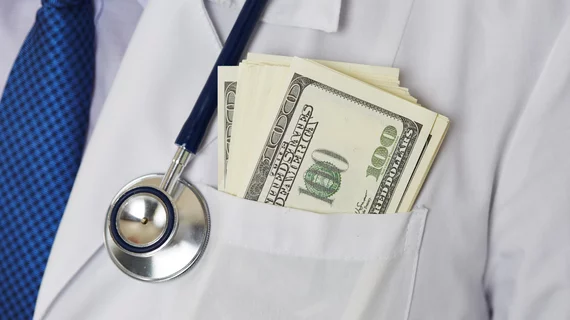Financial incentives significantly increase radiologist compliance with quality-improvement initiative
Paying radiologists a financial incentive significantly increased their participation in a healthcare quality-improvement initiative, according to new research published in JACR [1].
Osteoarthritis is the most common joint disease among adults, and its prevalence is growing amid an aging population. Plain radiograph is considered the first-line imaging tool for screening and diagnosing this concern. However, use of low-value MRI to assess knee pain is growing, experts noted.
UT Southwestern Medical Center has sought to address this concern among its radiology department, introducing a grading template in knee radiograph reports to decrease unnecessary MR imaging. The intervention appears to be working, with physician compliance leaping from 36% to 53% after inserting money as a motivator.
“Introduction of a financial incentive results in significantly increased adoption of [quality improvement] practices with sustained improvement among incentivized [musculoskeletal] radiologists compared to nonincentivized general radiologists,” Oganes Ashikyan, MD, and co-authors wrote Jan. 30.
UT Southwestern employs 12 fellowship-trained radiologists while five more general rads also handle knee radiograph reports. Both have differing incentive metrics, with the study authors using the five generalists as the control group. The hospital’s electronic dictation system is able to automatically insert a structured knee radiograph report template using the Kellgren-Lawrence system for classifying osteoarthritis. Radiologists can then choose to insert the appropriate KL grade in the report, with those rated 3 and 4 including a standardized statement noting that knee MRI is “typically not useful.”
Financial incentives were based on a six-month performance period and paid twice a year. The KL compliance metric accounted for about 30% of radiologists’ potential incentive, with clinical productivity making up the other 70%. On average, maximum incentive compensation for the quality metric was between 1% to 3% of radiologists’ total pay, the authors noted.
UT Southwestern first started offering the new financial incentive in March 2022. Ashikyan et al. analyzed a total of nearly 53,000 reports for their use of KL grading, including 42,000 handled by MSK radiologists and 11,000 more from general rads. Increases in compliance were greatest among the musculoskeletal specialist group during the adoption period (March to August 2022). And the change proved sustainable, with about 63% of subspecialized radiologists using the scoring system during the most recent post-implementation period (March to August 2023).
The improvement in compliance was less dramatic for general radiologists who did not receive a financial incentive, rising from 19% to nearly 28% (vs. 36% to 53% in the MSK group). It also was less sustainable, falling to 27% in the follow-up period.
Ashikyan and colleagues see other avenues for exploration on this issue.
“The findings and methodology of this study can be applied to other joints and other areas where MRI and other advanced imaging studies are overutilized,” the authors noted. “A further study that could directly expand on this study is to estimate the number of unnecessary MRIs that were not ordered due to the incorporation of KL grading templates, calculate the cost savings to the hospital and the patient, and compare it to the relative cost of the financial incentive.”

